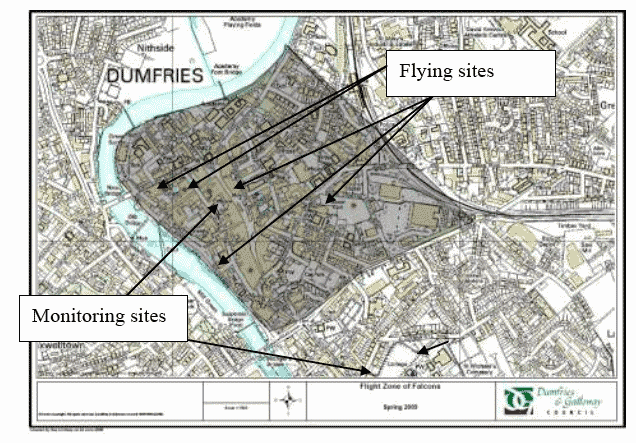Use of falcons to displace nesting gulls from an urban area: final report
Report following a 10-week trial of falconry flights within Dumfries Town Centre.
3. Methods
Falconry Deployment
Falconry was implemented over a ten-week period from the 16 th March through to the 22 nd May 2009. Up to eight different falcons were flown, independently, during the course of the project. Birds ranged in size from small male Peregrine x Lanner ( F. biarmicus) hybrids to larger female Peregrine x Lanner or Saker ( F. cherrug) hybrids, a pure female Peregrine, a pure female Saker and, briefly, a Gyr ( F. rusticolus) x Saker hybrid. Two staff needed to be used simultaneously for health and safety reasons. This limited the availability of personnel to implement the dawn to dusk programme and resulted in a routine 10-hour period of effort each day instead. The smaller falcons were deployed from the outset of the study with the larger birds introduced from week four onwards.
A series of vantage point locations were evaluated prior to commencement of the study and sites selected from which falcons could be flown and / or gulls could be monitored. One central rooftop was selected for monitoring gull behaviour within the Campaign Zone with another selected for monitoring behaviour outside the Control Zone. Three different rooftops were selected for preliminary falcon flights.
Access to the third roof was withdrawn at a late date resulting in monitoring effort being switched to the central council rooftop at the outset of the study. Further permissions were obtained for flying falcons from two other rooftops in the south and west of the Campaign Zone by week two of the study. Key sites are highlighted in Figure 1.
Figure 1. Campaign Zone for Falcons: Flying Sites (Red), Monitoring Sites (Blue).

The duration and range of falconry flights were increased as the project progressed. Initial flights retained direct line of sight contact between the falconer and falcon, involved regular stooping of a falcon to a lure from the same rooftop as they were released, and resulted in birds remaining in the air for approximately 5-6 minutes. Birds were flown three to four times an hour to habituate each individual falcon to the local area. Flight length and range was extended when the falconers were confident that birds had learned where each key rooftop within the Campaign Zone was located. By week three birds were flown, for example, between roof one and two, then from roof two to three and back again. Flights from the central roof routinely involved birds being released into the Campaign Zone and out over the northern quadrant of the Campaign Zone. This resulted in flights of falcons across the whole of the Campaign Zone. The process was continued for each bird as it was introduced to the programme. By the end of week four, falcons were frequently in the air and circuiting the area for a mean of over 30 minutes each hour. In very wet weather, birds were not flown.
Gull Behavioural Monitoring
Gull behaviour was recorded within four key categories:
- Undisturbed or Resting; birds on nests, sitting, standing, preening or displaying / interacting with conspecifics on the ground.
- Disturbed: birds visibly agitated but remaining on the ground.
- Flying: birds in flight, regardless of cause.
- Feeding; birds on the ground actively foraging,
Three hundred and sixty degree (360 o) paired scan samples recording the number of Lesser Black-backed ( Larus fuscus), Herring ( L. argentatus) and Great Black-backed Gulls ( L. marinus) exhibiting each behaviour were recorded on the hour or half hour from the monitoring sites. Gull ages were recorded as 'adult' or 'sub-adult' based on plumage characteristics. Coverage was limited to that which occurred on or directly above rooftops from which sitting or standing gulls could be observed from the vantage points.
A 360 o random number generator was used to select a gull (either on or clockwise from the angle presented), for individual focal observations. The selected gull was tracked and monitored for 10 minutes between each scan sample count and the time it spent exhibiting each behaviour type was recorded. Weather conditions including wind force and direction, precipitation, cloud cover and temperature were recorded each hour.
Monitoring was completed every hour on a randomly selected afternoon each week from midday to dusk and over the same regime from 7:00am to midday the following day. A total of 247 counts were completed.
Gull Censusing
The numbers of nesting pairs of Herring and Lesser Black-backed Gulls were obtained by a census count made by J. Coulson following cessation of the trial. In addition to recording nests, observations were made of the number of gulls present in predetermined areas of the town centre, the presence of breeding birds with traces of immature plumage (indicating recent breeding recruits), the number of gulls attracted to food on the riverside and in the town centre where the general public had complained about gull activity, and of evidence of interactions between gulls and the general public in the town centre. Nests were located by surveys at street level and searches from vantage points overlooking the town centre. The survey was a repeat of surveys from previous years using identical methodology to that described in Coulson & Coulson (2009). Exceptions were a change of vantage point from the former Social Security building in Irish Street to an adjacent roof, which gave a near comparable coverage. Data from this census were evaluated with reference to the specific Campaign Zone selected for the falconry trial and therefore deviates slightly from more general count data presented to Dumfries and Galloway Council in previous reports.
Contact
Email: Central Enquiries Unit ceu@gov.scot
There is a problem
Thanks for your feedback